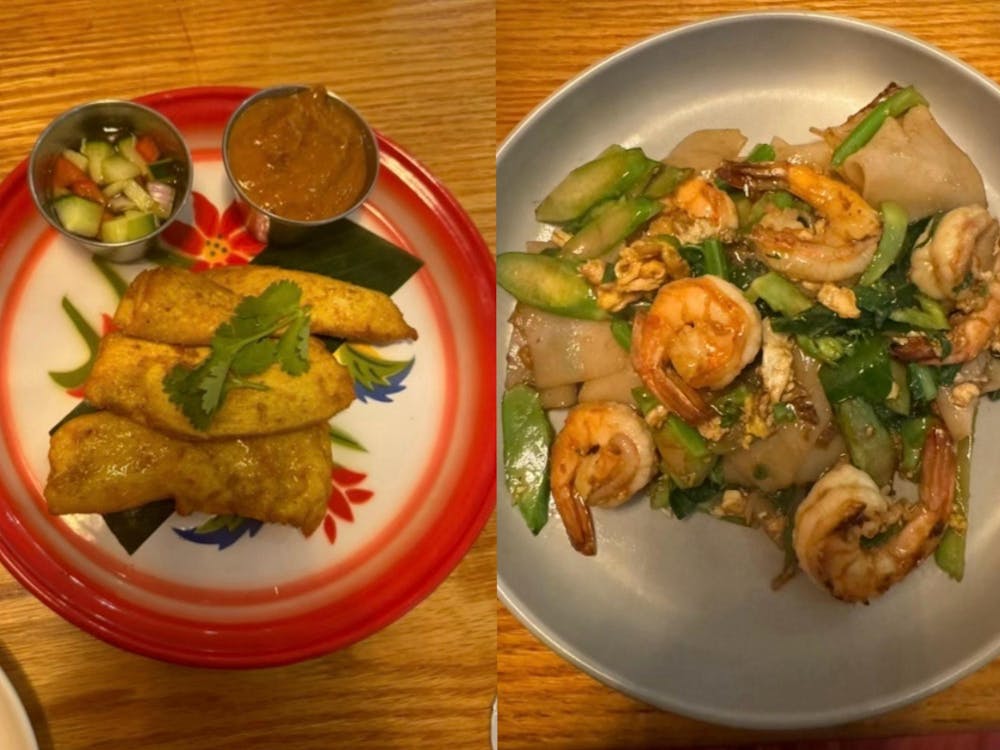Route 20 dead-ends 14 miles north of Charlottesville in a place called Barboursville, a tiny town consisting of one vineyard, several antique-looking gas stations, a few art galleries and the Muscle Car Paradise.
Frederick Nichols, artist and long-time resident of Barboursville, does not know the reasoning behind his neighbor's decision to build the low-slung garage dubbed "Paradise," which houses a troupe of 1950s era macho automobiles. But what he does know is the history of the town.
What used to be the main street of Barboursville has since become a collection of eclectic stores. At one time, though, there was an impressive collection of grocery stores and as many as five hotels.
"Barboursville grew up in 1880 when we got the second railroad," Nichols says as he motions to the railroad tracks that sweep through the block-long main drag of the town. Tumbleweeds roll through the dust past an apartment building not more than 20 feet from the railroad tracks.
"This is kind of like I-95 for trains," Nichols adds and glances down the tracks.
Had these same railroad tracks been allowed to pass through the nearby town of Gordonsville, Nichols says it might have usurped Charlottesville's place as a bustling commercial hub.
Nichols' namesake
Nichols himself almost feels he is a part of the town's history. Though originally a Charlottesville resident and a 1970 University graduate, the artist has made the small Virginia enclave of Barboursville his home for about 21 years.
He dawdles down the street and crosses the well-worn railroad ties to his own Nichols Gallery.
"We've been here about two and a half years," Nichols says. "This used to be an old hotel, the Estes Sparks Hotel, but that's all we know."
He pushes through the glass-paned door of the gallery, the small ping of a bell signaling his arrival.
"I bought this house from a guy who kept it as apartments," Nichols says. "He built walls and took out part of the banister, so when we came we had to kind of restore it."
|
Nichols motions to a few cracked panes and the scuffed, rough-hewn hardwood floor to illustrate his point. As an artist, he finds that the white-walled gallery exists best in a natural state, one he sees as closest to the original Sparks Hotel.
As he talks, Nichols' wife Beth comes down the groaning stairs with two blue mugs clinking together in her hands. She looks at her husband and smiles.
"I think you have to be a little bit insane to be in this business," Mrs. Nichols says. "You have to have a different outlook on life to be in this field."
Each room of the gallery is home to watercolor, acrylic, oil and mixed media paintings, all by various Virginia artists. The work of one artist, John Hancock, lines the walls of the foyer. Hancock integrates antique maps into his flowing mixed media works - a style that emanates the infamous signature of a different Hancock, the one who signed the Declaration of Independence in 1776.
An eye on the paintings, Nichols shoves his hands into his loose-fitting jeans, and begins the trek down to his personal studio.
A room of his own
From the outside, the aptly named Frederick Nichols Gallery looks more like a boutique than an artist's haven. With a wink, Nichols says this is no coincidence.
"The last business in here happened sometime between the demise of a general store and the time when we bought it," he says. "It had been a fancy dress shop."
The large bay windows, now devoid of mannequins, display Nichols' own work, which he refers to as "the wilderness."
Nichols unlocks the door and pushes inside to a low-ceilinged room where fluorescent light hovers over the bright mottled paintings of Virginia landscapes. One look at the work depicting cascades, golden fall leaves and rolling hills shows how Nichols feels at home here.
The artist leads the way to a cluttered back room where drying racks bump against each other and piles of unfinished prints are piled atop numerous drafting tables.
"Most of my work is oils, but some of it is printmaking," he says.
Amid shelves containing every imaginable type of art supply is Nichols' personal silk screening press.
"I started off with woodcuts, but it sort of evolved into silkscreen," Nichols says.
A work in progress sits on one of the plywood tables, waiting to have another color added. This particular piece will require anywhere from 30 to 40 colors - added with intricate technique - and like most of the others, will take several months to complete.
Nichols adds that because a press is used in the creation of such works many mistake them for reproductions.
"We refer to them as original prints" to differentiate them and show they are handmade, he says.
The next room in Nichols' spacious studio boasts a hand-installed strip of lighting that originally was designed for shows. With the opening of the gallery, however, it no longer serves that purpose and instead is used as a workplace.
One corner of shelves holds cases of the slides Nichols uses in his work. Nichols explains that his favorite times of the year are autumn and spring, but since those seasons last for only a few weeks in Virginia, he goes into the woods and takes pictures of different scenes. He then projects the slides from those pictures onto his canvas and paints over the image with oils or watercolors.
"It's kind of a ghost image almost, like a movie. You can kind of pretend you're there," he says.
Nichols also likes to create what he calls "sky paintings," where he studies the effect of light falling through leaves, giving what he terms a "stained-glass window effect."
Examples of this as well as his on-site watercolor sketches fill the rest of the wall space, giving the studio a feeling of being in a forest clearing where each tree is experiencing a different season.
Returning to the front room, Nichols explains a little about the process of woodcutting while showing one of his early pieces.
"I enjoy all these different mediums, but silk screening is my favorite," he says. "When I talk to others about silk screening, it's kind of like a disease. It's something you have to do."
Beyond the canvas
Back in the gallery, Nichols leans against a wall in the light-flooded foyer. Smells of cappuccino and chai waft from the lime-colored back room - the Bean Cafe - as two college-aged boys chop scallions and concoct various beverages chockfull with caffeine.
About a year and a half after Nichols and his wife started hanging their collection of Virginia paintings in the walls of the gallery, the couple decided to lease out a space for a coffee shop.
"With this cafe, we've met more people than we would have met - or even could have met - if this had just been the gallery," Nichols says.
Nichols says the experience of meeting so many people in his gallery and studio over the years has kept him glued to the spot.
School ties
Although most of Nichols' world now revolves between the block and a half that divides his studio and his gallery, he once was a student at the University too.
"I was one of three studio art majors in the College," he says and leans his head back as if propelling his mind backward in time. "The art department used to be in Cocke Hall. They had the whole building back then."
Nichols graduated the same year women first were enrolled in the University, and although he was enthused about the University becoming coed, Nichols says his father did not embrace the idea.
"My dad was an architecture professor then and he sort of opposed the whole thing," he says. "I think he was worried that the men wouldn't do as well with the added distraction."
After his graduation, Nichols went up to the Pratt Institute in Brooklyn for a few years before moving on to Massachusetts.
But before long, Virginia beckoned him home.
"There's just something about this place," he says quietly.
For him, Virginia is where his heart is, where he feels the filaments that loop between himself and his art are strongest. Here, he feels as if his own history has been stitched into the seams of the town of Barboursville.




